Name : Solanki Pratiksha M.
Paper : 6. The Victorian Literature
Subject : Assignment
Title : Devlopment of Drama in The Victorian Age.
Roll No. 23
Sem : 2
Submitted to :
Paper : 6. The Victorian Literature
Subject : Assignment
Title : Devlopment of Drama in The Victorian Age.
Roll No. 23
Sem : 2
Submitted to :
Smt. S.B.Gardi
Dept. of English
Dept. of English
Maharaja Krishnakumarsinhji Bhavnagar University
pratikshasolanki068@gmail.com
Development of Drama In The Victorian Age : :
Introduction ::
The Victorian Era was a period of full of changes. It is most important reign of Queen Victoria and her reign consider one of the most important in her time. The writers had to follow the reforms of the time. The Romanticism continued being the main theme of the Victorian's era novels but some writers are focused on the development of English democracy and the industrial progress.
In The Victorian era people believes and belief in discipline, in savings, in such a way those good manners were essential requirements for the development of a civilized life style.
Drama ::
Drama is the specific mode of fiction represented in performance, it is often combined with music, dance, etc.. The use of drama in narrow sense to designate a specific type of play. Drama in this sense refers to a play that is neither a comedy nor a tragedy.
>> Robert Browning
Robert Browning was an English poet and playwright whose mastery of dramatic verse, especially dramatic monologues. Robert Browning was born in Camberwell.
His father was a well-paid clerk for the Bank of England. The reminder of Browning's life was occupied with journeys between England, France and Italy and with different activities. Robert was raised in a household of significant literary resources.
His Style ::
Browning's style has been the subject of endless discussion, for it presents a fascinating problem. He is master of several varieties of metrical forms and excels in the manipulation of rhythmic effects.
His Plays ::
The Pied Piper of Hamelin (1842 )
Browning's plays are very well presented by him and in Sardello, it is an attempt to decide the relationship between art and life is Browning's most obscure work.
>> Charles Reade ( 1814-84 )
 Charles Reade was an English novelist and dramatist, best known for The Cloister and the Hearth. Charles Reade was born at Ipsden, Oxfordshire, to John Reade and Anne Marie Scott-Waring, and had at least one brother. Reade start his literary career as a dramatist, he chose to have
"dramatist" stand first in the list of his occupations on his tombston.
Charles Reade was an English novelist and dramatist, best known for The Cloister and the Hearth. Charles Reade was born at Ipsden, Oxfordshire, to John Reade and Anne Marie Scott-Waring, and had at least one brother. Reade start his literary career as a dramatist, he chose to have
"dramatist" stand first in the list of his occupations on his tombston. His Style ::
As a playwright he had a fair amount of success. He has the dramatist's sense of situation, and his gift is for striking scenes rather than the careful integration of plot. Often he is melodramatic and his characters lack subtlety and his dialogue shows the influence of his theoretical experience.
His Work ::
Mask and Faces ( 1852 ) written in collaboration with Tom Taylor
Peg Waffingten ( 1853 ) was his first novel and followed by Christie Johnstone
Hard Cash ( 1863 ) is an attack upon private lunatic asylums..
His many drama and novels are most popular and very well written by him.
>> Charles Dickens ( 1812-70 )

Charles John Huffam Dickens was an English writer and social critic. He created some of the world's most memorable fictional characters and is generally regarded as the greatest novelist of the Victorian period. His novels, dramas and short stories continue to be widely popular.
His Work ::
Oliver Twist ( 1837 )
Nicholas Nickleby ( 1838 )
The Old Curiosity Shop ( 1840 )
Barnaby Rudge ( 1841 ) etc..
>> Algernon Charles Swinburne ( 1837 - 1909 )
Algernon Charles Swinburne was an English poet, playwright, novelist, and critics. He wrote several play and novels and contributed to the well known 11th edition of the Encyclopedia Britannica. Swinburne was born at 7 Chester Street, Grosvenor Place, London, on 5 April 1837.
His Work ::
Chastelard, a Tragedy
The Sisters ( 1892 )
Bothwell ( 1874 )
Mary Stuart ( 1881 ) etc..
The gift of Swinburne are lyrical rather than dramatic and his tragedies like those most of his contemporaries, are only of literary importance.
Tennyson was born in Somersby. He was born into a middle-class line of Tennysons, but also had a noble and royal ancestry. Tennyson was first a student of Louth Grammar School for four years.
His Work ::
Queen Mary ( 1875 )
Harold ( 1876 )
Becket ( 1884 )
His Style ::
No one can present more finely than he moods appropriately and external nature includes characters in stationary position and there is splendid spirit in his narrative passage of different action.
No one can present more finely than he moods appropriately and external nature includes characters in stationary position and there is splendid spirit in his narrative passage of different action.
" So many worlds , so much to do , so little done , such things to be.. "
Thank you..











